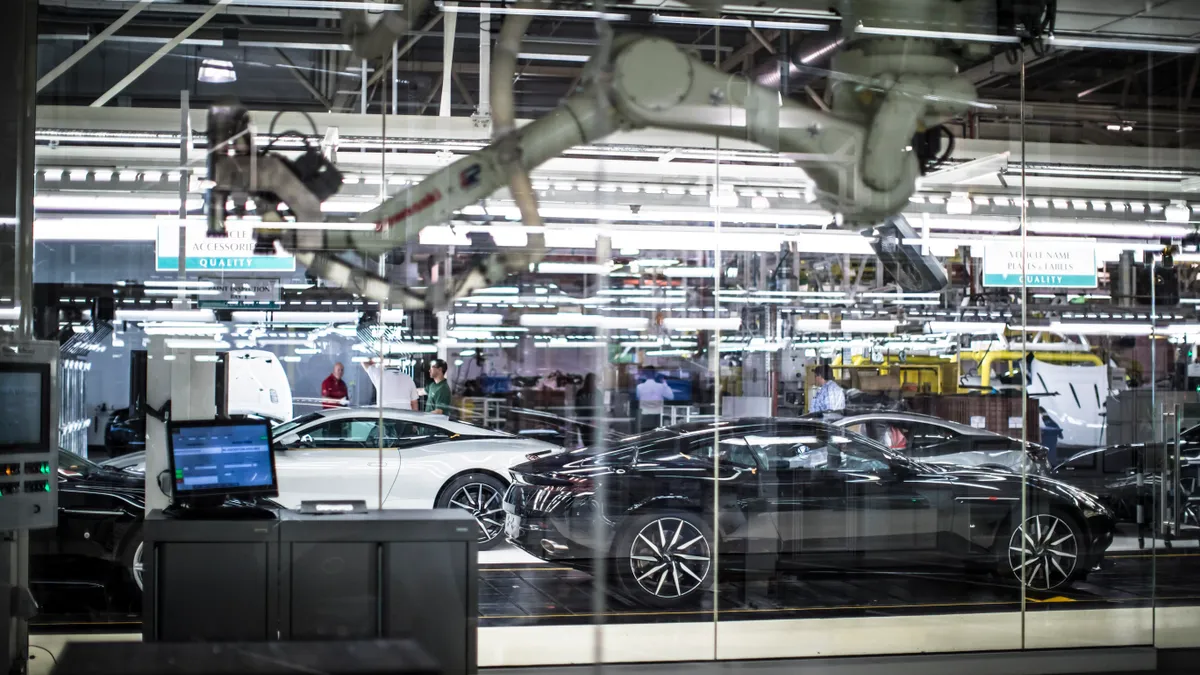Dive Brief:
- The U.S. PMI climbed from 41.3% in May to 52.6% in June, breaking multiple historic records for production and new order growth indicators, according to the Institute for Supply Management (ISM). This marks the first time the manufacturing sector has seen expansion since July 2019, based on ISM's records. A PMI reading above 50% indicates growth and below 50% indicates decline.
- Despite posting the fastest month-over-month growth rate since August 1980, June's figure does not capture the impact of the nationwide spike in coronavirus infections in recent weeks, Timothy R. Fiore, chair of ISM's Manufacturing Business Survey Committee, told Supply Chain Dive in an interview. He expects there could be a decline to around 48% in July, depending on the pandemic's course.
- The U.S. is "probably looking at a 48.5% or 52% PMI for the rest of the year," Fiore said. "I don't really see anything that is going to significantly change. I don't see any governor shutting down another state. I see a lot of municipalities and counties making determinations on stay-at-home orders. And when they do that, they're going to affect companies within industries, but not whole industries, and not the whole manufacturing [sector]."
Dive Insight:
The U.S. manufacturing sector hit the "bottom of the toboggan run" in April, according to Fiore, when the PMI was 41.5%. While the figure improved slightly in May, rising to 43.1%, the increased pace of state reopenings in June (and the stabilization of factory operations in China and the U.S.) finally propelled the industry into growth territory.
However, Fiore emphasized that these numbers, while encouraging, should be taken with a grain of salt. "Essentially, you got a rebound off a low base, expanding at a decent level but not great," he said. "It really reflects the reopening of the economy from the bottom that you saw in April and May. [But] I think it doesn't reflect what's currently happening."

Underlying these PMI results is an ongoing surge in consumer demand for goods from cleaning supplies to spices and electronics, even hitting peak season levels in some cases.
United Natural Foods (UNFI) CEO Steve Spinner said on an earnings call in June that grocery suppliers aren't likely to reach pre-coronavirus inventory levels until the fall, with the risk of stock-outs looming in the meantime.
Likewise, McCormick is in the process of switching over factories to 24/7 operations to replenish products and keep up with increased demand driven by more consumers cooking at home. "By the end of the year we will have added the equivalent of an additional plant of U.S. manufacturing" in addition to onboarding new co-manufacturers, CEO Lawrence Kurzius said on a company earnings call on June 25.
There are signs that upstream production and supplier operations are stabilizing, Fiore said.
"The last three months left suppliers scrambling like crazy," he said. "Transportation equipment was hard to acquire. Drivers didn't want to go to work. Suppliers are shutting down their own factories because of virus issues and so on." That the PMI has begun to rebound in earnest, he said, is a sign supply and production are becoming more synchronized.
The question now is how consumer demand will respond as true peak season arrives, given persistent unemployment and individuals choosing to stay home rather than risk returning to work during the pandemic.
"We're already in peak season," Fiore said. ISM scrapped seasonality as a variable in June's PMI, given the unprecedented demand increases in thriving categories including food and beverage, consumer products and personal protective equipment (PPE), finding it had an impact of half a percentage point.
For example, "automotive is uncertain, because on the one hand you got people not wanting to take public transport, transportation," he said. "On the other hand, you got people not driving to work." Therefore, predicting how well consumer demand will respond after June's initial manufacturing recovery, and where it will spike or decline, is uncertain and will likely be difficult to predict for some time to come, he said.













